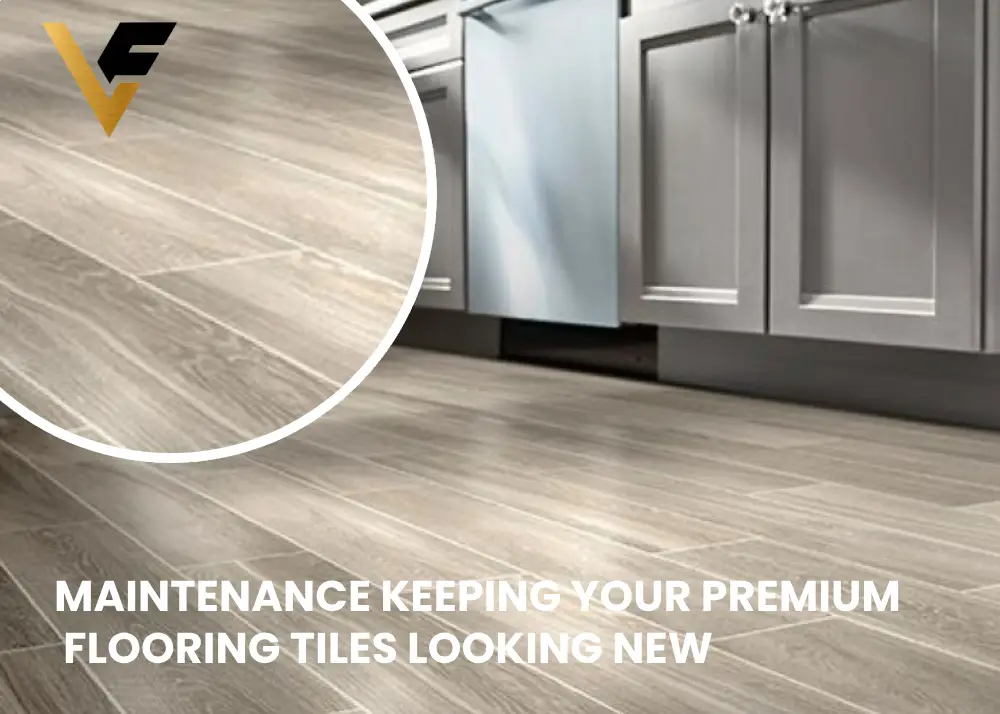Premium flooring tiles add a touch of elegance and luxury to any home, enhancing its aesthetic appeal and increasing its value. However, to maintain their pristine condition and ensure they look new for years to come, regular maintenance and proper care are essential. Whether you have ceramic, porcelain, marble, or other types of premium tiles, this comprehensive guide will provide you with the latest tips and strategies for keeping your flooring tiles in top-notch condition.
1. Understanding Your Tile Type
Ceramic and Porcelain Tiles
Ceramic and porcelain tiles are popular for their durability, water resistance, and ease of maintenance. While ceramic tiles are made from natural clay and are often glazed to create a protective layer, porcelain tiles are denser and more impervious to moisture, making them suitable for both indoor and outdoor use.
Marble and Natural Stone Tiles
Marble and natural stone tiles, such as granite, slate, and travertine, offer unparalleled beauty and uniqueness due to their natural variations. However, they require more specialized care compared to ceramic and porcelain tiles due to their porous nature and susceptibility to staining and etching.
Glass and Mosaic Tiles
Glass and mosaic tiles are often used for decorative purposes, such as backsplashes and accent walls. While they are relatively easy to clean, they can be more delicate and prone to chipping compared to other tile types.
2. Daily Maintenance Tips
Regular Sweeping and Vacuuming
Dust, dirt, and debris can act as abrasives on your tile surface, causing scratches and dulling the finish. Regular sweeping or vacuuming with a soft-bristle attachment can help prevent this. Aim to sweep or vacuum your floors at least once a day, especially in high-traffic areas.
Mopping with the Right Cleaners
Mopping your tiles with the right cleaner is crucial to maintaining their shine and preventing residue build-up. Use a pH-neutral cleaner specifically designed for your type of tile. Avoid using harsh chemicals, bleach, or acidic cleaners, as these can damage the tile surface and grout. For natural stone tiles, use a cleaner formulated for stone to avoid etching and discoloration.
Dealing with Spills Immediately
Spills should be cleaned up promptly to prevent staining and damage. Use a soft cloth or paper towel to blot the spill, then clean the area with a mild cleaner and water. Avoid scrubbing the spill, as this can spread it and cause further damage.
3. Deep Cleaning Techniques
Ceramic and Porcelain Tiles
For a deeper clean, mix a solution of warm water and a few drops of dish soap or a specialized tile cleaner. Use a microfiber mop or soft cloth to clean the tiles, ensuring you rinse the mop frequently to avoid spreading dirt. For stubborn stains, a paste of baking soda and water can be applied to the stain, left for a few minutes, and then scrubbed gently with a soft brush.
Marble and Natural Stone Tiles
Deep cleaning natural stone tiles requires more caution. Use a pH-neutral stone cleaner and a soft cloth or mop. Avoid using vinegar, lemon juice, or other acidic substances, as they can etch the stone surface. For stains, a poultice made from a mixture of baking soda and water can be applied, covered with plastic wrap, and left overnight before rinsing off.
Glass and Mosaic Tiles
Glass and mosaic tiles can be cleaned with a mixture of water and a few drops of dish soap. Use a soft cloth or sponge to wipe the tiles, and a soft brush to clean the grout lines. For hard water spots or soap scum, a mixture of equal parts vinegar and water can be used, but be cautious with the grout, as vinegar can degrade it over time.
4. Maintaining Grout Lines
Regular Cleaning
Grout lines can easily become dirty and discolored due to their porous nature. Regularly cleaning the grout with a mixture of water and a mild cleaner can help prevent this. Use a soft brush to scrub the grout lines gently.
Sealing Grout
Sealing grout can help protect it from stains and moisture. Depending on the type of grout and the level of foot traffic, grout should be sealed every six months to a year. Use a penetrating grout sealer and apply it according to the manufacturer’s instructions.
Dealing with Stains
For stained grout, a paste of baking soda and water can be applied and left for a few hours before scrubbing gently with a soft brush. For tougher stains, consider using a commercial grout cleaner or a mixture of hydrogen peroxide and baking soda.
5. Preventive Measures
Using Mats and Rugs
Placing mats and rugs in high-traffic areas and entryways can help reduce the amount of dirt and debris that gets tracked onto your tiles. Use non-slip, breathable mats to prevent moisture from getting trapped underneath.
Furniture Pads
Attaching felt pads or rubber caps to the bottom of furniture legs can prevent scratches and scuffs on your tile flooring. Check the pads regularly and replace them as needed.
Avoiding High Heels and Sharp Objects
High heels and sharp objects can cause damage to your tile surface. Encourage family members and guests to remove their shoes before walking on tile floors, and avoid dragging heavy or sharp objects across the tiles.
6. Addressing Common Issues
Cracked or Chipped Tiles
Cracked or chipped tiles should be addressed immediately to prevent further damage and maintain the integrity of your flooring. For minor chips, a tile repair kit can be used to fill in the damaged area. For larger cracks or broken tiles, it may be necessary to replace the tile. Ensure you have spare tiles from the original installation for an exact match.
Discoloration and Stains
Discoloration and stains on tiles can often be remedied with a thorough cleaning. For stubborn stains, identify the cause (such as oil, rust, or mildew) and use an appropriate cleaner. For example, oil stains can be treated with a degreaser, while rust stains may require a commercial rust remover.
Loose or Hollow-Sounding Tiles
Loose or hollow-sounding tiles may indicate a problem with the adhesive or substrate. This issue should be addressed by a professional to prevent further damage. In some cases, the tile may need to be removed, the substrate repaired, and the tile reinstalled.
7. Seasonal Maintenance
Winter Care
In colder climates, winter can bring challenges such as salt and moisture from snow and ice. Use a doormat to catch salt and moisture before it gets onto your tiles. Wipe up any water or slush immediately to prevent slipping and potential damage to the grout.
Summer Care
During the summer, sand and dirt can be tracked in from outside. Increase the frequency of sweeping and mopping to keep your tiles free from abrasive particles. Consider placing mats at entryways to catch dirt and sand.
8. Professional Maintenance
Periodic Professional Cleaning
Hiring a professional cleaning service periodically can help maintain the pristine condition of your premium tiles. Professional cleaners have the tools and expertise to deep clean and polish your tiles, restoring their original shine and beauty.
Re-sealing and Polishing
Professional services can also re-seal natural stone tiles and grout, as well as polish marble and other natural stones to remove scratches and restore their luster. Schedule these services annually or as needed, depending on the wear and tear your flooring experiences.
9. Sustainable Cleaning Practices
Eco-Friendly Cleaners
Using eco-friendly cleaners can help maintain the beauty of your tiles while protecting the environment. Look for cleaners that are biodegradable, non-toxic, and free from harsh chemicals. Many natural ingredients, such as baking soda, vinegar, and lemon juice, can be effective cleaning agents when used correctly.
Water Conservation
When cleaning your tiles, be mindful of water usage. Use a damp mop rather than soaking the floor, and only use as much water as necessary. This not only conserves water but also helps prevent excess moisture from seeping into the grout and substrate.
10. Conclusion
Maintaining the beauty and integrity of your premium flooring tiles requires a combination of regular cleaning, proper care, and preventive measures. By understanding the specific needs of your tile type and implementing the strategies outlined in this guide, you can keep your tiles looking new and pristine for years to come. Whether you have ceramic, porcelain, marble, or another type of premium tile, these tips will help you protect your investment and enjoy the elegance and luxury of your flooring for a lifetime.


